




The highly appealing and emotionally charged Mercedes-Benz E-Class Cabriolet is the latest addition to the successful E-Class line-up. The open-top two-door model, which went on sale on 11 January 2010, features a classic fabric soft top, making for a stylistically pure cabriolet feeling. Viewed from the side, the new model is an intriguing proposition - with its clear proportions and a flawless cabriolet silhouette.
In keeping with the motto "four seasons, four personalities", all-year-round suitability was right at the top of the developers' list of priorities. With the new E-ClassCabriolet, the cabriolet season lasts the whole year because, while many cabriolets tend to disappear from the roads of Western Europe in the autumn, the Mercedes-Benz E-ClassCabriolet (length/breadth/height: 4698/1786/1402 mm) provides driving pleasure and comfort whether the roof is open or closed.
New features include:
* The AIRCAP® automatic draught-stop: always on board and easily controllable at the push of a button, it reduces turbulence substantially for all four seat occupants
* The modified AIRSCARF® neck-level heating system
* The acoustic soft top fitted as standard
The soft top can be opened and closed fully automatically within 20 seconds - even when driving at speeds of up to 40 km/h. The cabriolet roof is stowed in a special compartment behind the rear panel. A retractable cover separates the soft top compartment from the boot area; it must be closed in order to close the soft top. If the roof is to remain closed, the cover can be slid rearwards, in which case the boot capacity is increased by 90 litres to 390 litres. A through-loading feature is included as standard for the newCabriolet, as is EASY-ENTRY - a manually operated entry and exit aid for the rear passengers.
Mercedes-Benz E-Class Cabriolet
Mercedes-Benz E-Class Cabriolet
The powerplants for the new Mercedes-Benz E-Class Cabriolet are equally innovative: the new direct-injection diesel and petrol models combine efficiency with effortlessly superior power delivery. The exemplary, low fuel consumption has not only been achieved because of the new engines, but also with a number of practical measures. These include on-demand activation of the steering and fuel pumps, the use of tyres with low rolling resistance and an alternator control system which takes account of the current driving situation and the vehicle's electrical power requirements, plus the crucial factor of outstanding aerodynamics. TheCabriolet 's cd figure of 0.28 is the best in its class, marking a continuation of the Mercedes-Benz E-Class success story in the field of aerodynamics.
Less turbulence, easier to use: AIRCAP® is a world-first
In 1989, Mercedes-Benz introduced a world premiere in the shape of a draught-stop for the Mercedes-Benz SL-Class, followed in 2004 by the AIRSCARF® neck-level heating system to further enhance comfort in open-top models. Now comes another world-first: the AIRCAP® automatic draught-stop, which can be activated at the push of a button, greatly reduces turbulence in the interior of the new Mercedes E-ClassCabriolet , creating a sea of warm air. It is also much easier to implement and use than conventional draught-stops: there is no tricky installation, the two individual rear seats remain free and theCabriolet 's flowing side lines remain uninterrupted. AIRCAP® is therefore a classic Mercedes innovation: functional, comfort-enhancing, elegant and safe.
AIRCAP® consists of two components: a wind deflector that can be extended by around six centimetres with a net in the windscreen frame and a draught-stop between the rear seats.
The functions of the two components:
* Elevation of the free flow above the interior
* Net at the front increases the basic pressure in the interior
* Draught-stop at the rear reduces the backflow
As well as enhancing occupant comfort and wellbeing, the reduction in draught when AIRCAP® is activated (it can be activated at speeds of up to 160 km/h and remains in use right up to the car's top speed) reduces the interior noise level - so passengers in all seats find it far easier to communicate.
The Cabriolet Comfort package includes AIRCAP® with AIRSCARF®. This patented system functions like an invisible scarf, which warms the occupants' head and neck areas. AIRSCARF® is integrated into the backrests of the front seats and provides warm air through outlets in the head restraints.
The Mercedes engineers have modified this unique innovation specifically for the Mercedes-Benz E-Class Cabriolet: in this model, an adjustment wheel pivots the outlet nozzle upwards and downwards by a total of 36 degrees over and above the head restraint height adjustment, meaning that the driver and front passenger can enjoy the unique neck-level heating regardless of how short or tall they are.
Design: The stuff of which cabriolet dreams are made
From the very first drawings onwards, the Mercedes designers were sure of one thing: only a classic fabric soft top can convey a stylistically pure cabriolet feeling. Consequently, the new Mercedes-Benz E-Class Cabriolet, which combines an elegant appearance with a high awareness of tradition, had to have a soft top. Viewed from the side, the two-door model therefore offers an enticing mix of clear proportions and a flawless cabriolet silhouette, including a long bonnet, wide doors, a high beltline with elongated side windows, a lowered soft top contour, and a short rear overhang. This look is complemented by the powerfully muscular section in the side wall at the rear axle and a slender C-pillar.
As well as sharing family traits with the other E-Class models, the new Cabriolet has its own, distinct identity characterised by a greater sense of passion. The arrow shape of the entire front section from front bumper to radiator grille tobonnet , the more extreme interpretation of the twin headlamp face and its more sinewy build give it a racier and more dynamic presence than the Saloon. At the same time, the close family ties with the E-Class Coupé are clearly apparent.
Powerful styling accentuates the sleek, flowing lines
A special characteristic of the contemporary Mercedes design idiom is the creative interplay of edges and surfaces. Taut, sharply defined lines, which grow out of surfaces organically and disappear into them again equally gently, structure the sides of theCabriolet . The high shoulderline, a prominent, downward-pointing feature line (another contemporary Mercedes styling element) and a second structuring line delimit the sensitively sculpted surfaces. Alternately concave and convex, these create a sleek yet sharply defined flow of lines which creates a fascinating interplay of reflected incident light.
Arrow-shaped front and dominant radiator grille
From the front bumper to the radiator grille to the bonnet, the pronounced arrow shape of the front section emphasises the sporty character of the Cabriolet. A central crease in the bonnet picks up this shape and trails back towards the windscreen. A wide, upright radiator grille with two louvres, striking chrome strips, a powerful chrome surround and the central star testifies to status and self-assurance in time-honoured Mercedes style. The grille makes an effortlessly superior, expressive statement of the brand's identity.
The traditional twin headlamp face is based on that of the new E-Class Saloon, but has its own distinct identity. Longer, more sharply inclined and flatter, the headlamps have a more dynamic look which is unmistakable. With their elaborate, high-tech interior and quadrant-shaped indicators, they add a sparkling finishing touch to the front of the car.
A distinctive front apron with large air intakes gives the vehicle a strong, powerful presence. Two vertical struts in the front apron provide visual support for the radiator grille and give it a substantial formal base. Depending on the model version, the bumper houses either the fog lamps or the daytime driving lights and fog lamps side by side. In the versions with bi-xenon headlamps, L-shaped daytime driving lights based on LED technology give the car an expressive look.
Powerful rear with innovative lights
"Powerful and not afraid to show it" could be the motto for the rear section of the new Mercedes-Benz E-Class Cabriolet: the rear wings spanning the rear axle are sculpted to create a powerful, muscular form which visually enhances the car's width. The distinctive feature line - a characteristic Mercedes styling element - is continued masterfully around the back of the vehicle and into the tail lights, thereby forming a link between front and rear.
The LED tail lights are split and extend from the boot lid far into the side wall. In so doing, they emphasise the width and dynamism of the vehicle. Their innovative lighting technology is particularly noteworthy. An LED background lighting system provides indirect illumination of the three-dimensional back cavity in both light units and in this way sets the basic background lighting tone. Twin light arrays with twin LED light guides stand out against the background lighting. These light arrays accommodate the tail lights and the brake lights, while the reversing lights and the LED-fog lamp are integrated in the boot lid light clusters.
The narrowness of the gap between the light unit on the boot lid and that on the side wall, as well as the extremely precise bevelling of the adjacent light lenses allows light transmission between the two sections. As a result, the night design of the new Cabriolet maintains the perceived width and harmonious appearance of the rear section.
Interior with sporty lines and high perceived value
In the interior, the designers have continued the taut, sporty design idiom of the exterior. The compelling interplay of surfaces and clearly defined lines creates an interior whose elegance and high perceived value are evocative of modern architecture. The cockpit is structured horizontally with a dark upper section in order to avoid unwanted reflections. Interior appointments in two colours - in keeping with the logic of the two-level structure - create intriguing contrasts.
With its sporty look and feel, the cockpit design is clearly in keeping with the agile character of the new Cabriolet. The instrument cluster with five tubes for the dials and a central display has a slender look, while the dials themselves are clearly laid out and have high-quality chrome surrounds as well as a silver backing for the scales. The background colour of the dashboard is silver or black, depending on the choice of trim parts. The three-spoke steering wheel with multifunction buttons is available in a number of different versions and colours in order to match the interior appointments.
Next to the instrument cluster - and therefore in the primary field of vision of the driver and front passenger - is the display area for the control and display system for the radio, navigation system and other functions. The system is operated by means of a rotary and push-action Controller, which falls conveniently to hand in front of the asymmetrically split armrest between the front seats. This armrest also serves as a handrest when operating the Controller. Beneath this are the control buttons for the soft top and AIRCAP®. The horizontally divided dashboard merges into a dynamic, arrow-shaped centre console in which the air-conditioning controls, for example, are integrated.
Sporty individual seats for the rear passengers, too
The new Mercedes-Benz E-Class Cabriolet is an out-and-out four-seater and also has sportily designed individual seats in the rear. The front integral seats with pronounced, faceted side bolsters and transverse piping on the seat cushion have a light,
contemporary look and immediately create a distinctly sporty impression, while offering excellent seating comfort. Another notable characteristic of the seats is the high-quality, hand-stitched workmanship featuring discreet flat-felled seams. Further highlights include the audio system's loudspeakers housed in the soft top compartment cover, which add an extra visual touch, especially when the roof is open
Fine materials
The whole interior is dominated by pleasing surface finishes. Trim elements made from valuable, authentic materials emphasise the high-quality of the new Cabriolet. The sporty two-door model is equipped as standard with brushed aluminium trim parts with a sporty spin finish. Customers can also choose from fine woods: burr walnut, high-gloss black ash or the graphic linearity of pine. In all cases, the trim parts have a thin chrome strip along their upper edge.
The bodyshell: Solid basis reinforced at specific points
A robust basis is the ideal ingredient for a stiff bodyshell offering a high level of crash safety. It plays a decisive role in ensuring maximum noise-related comfort, outstanding vibration characteristics and hallmark Mercedes-Benz longevity. In these terms, the Mercedes-Benz E-Class Cabriolet had an ideal starting position, given that it is closely related to the E-Class Coupé - a two-door model which meets the very highest requirements when it comes to torsional stiffness and occupant protection.
The same applies to the Cabriolet, which has one of the stiffest designs in its segment. The body's static torsional stiffness can be seen as a reliable indicator of the excellent cumulative effect of the implemented measures. It has been increased by around 30 percent compared to the outgoing model.
To achieve this figure, the bodyshell of the Mercedes-Benz E-Class Cabriolet received extra reinforcements compared to its Coupé sister model, the most important of which are as follows:
* The extremely robust A-pillar assembly consists of two high-strength steel tubes which are welded to the sheet-metal shells of the A-pillars. In the case of the Mercedes-Benz E-Class Cabriolet, both tubes have an exceptionally robust Y-shape and stretch from the A-pillar intersection to the upper window frame.
* The plug-in B-pillars are extremely robustly connected as they engage in the side skirts, thus offering highly effective protection in the event of a crash. A shoe made from ultra-high-strength steel braces the inside of the B-pillar against the rear seat crossmember. The rear support against the rear panel runs in an arch-like shape to the rear seats.
* Reinforced side skirts and bulkhead platesin the doors protect the occupants in a lateral impact with a pole, for example. Likewise the reinforced shoulderline with its high-strength steel section enhances the exceptionally robust nature of the design.
* The floor assembly has been reinforced solidly at several points.
* The robust rear panel behind the rear seats further enhances the body's lateral rigidity.
Intelligent lightweight construction: state-of-the-art materials and innovative joining techniques
Despite the enhanced spaciousness, comfort and safety compared to the outgoing model, the weight of the bodyshell has been kept practically the same for the new Mercedes-Benz E-Class Cabriolet thanks to intelligent lightweight construction. High-strength steel alloys account for around 60 percent of the weight. In the case of the side skirts alone, this high-strength, low-weight material reduces weight by some five kilograms.
The design and construction of the bodyshell are likewise weight-optimised. The energy-absorbing front crossmember, for instance, is inserted into the longitudinal members and no longer ends in flange plates. Tailored Blanks made from sheet steel are used in many places, such as on the underbody, where individual blanks of varying thickness and strength are joined by means of laser welding, or on the transmission tunnel, where the blanks optimise structural behaviour and crash performance.
In addition to these measures, the use of state-of-the-art structural adhesive plays a further important part in enhancing the body strength. The total length of the high-strength adhesive seams used in the bodyshell of the Mercedes E-Class Cabriolet amounts to around 70 metres.
Mercedes-Benz employs innovative "RobScan" robot-guided laser welding for the Mercedes-Benz E-Class Cabriolet. This new welding technology allows a very high welding speed with optimum weld quality. The technology is used in the rear centre section of the Cabriolet - with a total of 26 welds.
Quality right from the start: visual inspection and NVH optimisation
Alongside the usual quality assurance measures, all joining techniques are subject to process monitoring, which ensures quality in each individual stage of production. The MIG (metal inert gas) solder seams, for instance, are monitored by means of a 3D light-strip sensor. The position, width and completeness of the adhesive seams are checked by an integrated camera when the adhesive is applied. The spot welds likewise undergo a visual inspection: the photos taken by a thermography camera confirm whether the spot welds have the correct diameter.
A further important aspect of quality is a car's NVH behaviour (noise, vibration, harshness). Here, too, the bodyshell plays a key role. Sturdy transverse sections in the floor assembly - known as transmission tunnel braces - along with optimised lower seat crossmember sections and reinforced engine mounts are just some of the NVH measures implemented to improve vibration characteristics.
Easy to repair: reversible bonnet
Development of the E-Class body focussed on customer benefit at all times, as shown by the Active Bonnet, which reduces the risk of injury to pedestrians and features a reversible design.
Further easy-to-repair and, therefore, money-saving solutions include the bolted-on crash boxes at the front and rear as well as the radiator fastening.
The roof: Exemplary quiet-running
Thanks to its acoustic soft top, fitted as standard, the Mercedes E-Class Cabriolet has one of the quietest interiors in the segment for four-seater premium cabriolets with a fabric roof. The soft top's exceptionally high-quality insulation brings about a clearly noticeable reduction in the interior noise level compared to conventional fabric soft tops. Exterior noise caused by other vehicles and wind noise are therefore absorbed more effectively. On the road, the difference is audible from speeds of just 80 km/h, for example when driving through a tunnel or overtaking a convoy of trucks. At higher speeds, the benefits of the acoustic soft top are even more tangible. For instance, it is possible to have a perfectly normal phone conversation in hands-free mode even when travelling at a speed of over 200 km/h.
Three new developments enabled the Mercedes-Benz engineers to reduce the interior noise level substantially: the outer fabric coating on the soft top has been acoustically optimised, while a butyl layer in place of the previous neoprene layer on the inside acts as a water barrier. Finally, the intermediate felt layer is structured differently to that of the previous model. This layer also ensures that the elegant silhouette is not disturbed by bows visible from outside.
The Mercedes-Benz E-Class Cabriolet likewise sets new standards when it comes to all-round visibility - important for both looks and safety. The soft top fabric in the C-pillar area-is extremely slender thanks to the sophisticated kinematics of the rear windscreen which, rather than being rigidly fixed in place, moves out of the soft top fabric when the roof is opened and closed. Special water pockets prevent moisture ingress at the sides.
Of course, the soft top itself is also waterproof and windproof. Plus it can be put through an automatic car wash without any hesitation. With a total thickness of 23.5 millimetres, the fabric soft top offers excellent thermal insulation, meaning that the Mercedes E-Class Cabriolet is also ideal for use in winter. The heated rear windscreen is made of glass and is therefore scratchproof. The soft top is available in black, blue or beige.
Supreme ease of use was a key criterion when developing the soft top, which is hydraulically operated by means of seven cylinders pressurised by an electric pump. Fully automatic opening and closing of the roof takes around 20 seconds and is possible at speeds of up to 40 km/h. A pull on the control on the centre tunnel is all it takes. Alternatively, the roof can be controlled remotely by pressing a button on the key. The soft top engages automatically at the front roof crossmember.
The soft top is stowed in a special compartment behind the rear panel. A retractable cover separates the soft top compartment from the boot area; it must be closed in order to close the soft top. If the roof is to remain closed, the cover can be slid rearwards, in which case the boot capacity is increased by 90 litres to 390 litres.
Differences between the exterior and interior air pressures can cause a ballooning effect on certain cabriolet models when travelling at high speed. But not in the case of the Mercedes-Benz E-Class Cabriolet: a special zip fastener is used to fasten the soft top firmly to the frame over all three bows. This fastening and the short fabric lengths between the supports are effective at preventing ballooning of the roof when travelling at high speed. Sophisticated test equipment was used to measure and document this effect during the road-testing phase.
The cabriolet specialists at Mercedes-Benz also attach great importance to the durability of the fabric soft top. Hence the roof is designed for 20,000 load cycles - the highest figure in this competitive environment - equivalent to opening and closing the soft top once on every day of the year for over 25 years. In the unlikely event of the fully automatic closing mechanism failing, for example due to a flat battery, Mercedes-Benz has seen to it that E-Class Cabriolet drivers will not be left in the rain, since the hydraulic system can be depressurised quickly, enabling the soft top to be closed and locked by hand.
The drive system: Powerful and extremely efficient
With its newly developed direct-injection diesel and petrol engines, Mercedes-Benz has taken further strides forward in its quest to reduce both fuel consumption and exhaust emissions - without compromising on agility and driving enjoyment. The line-up of powerful and extremely efficient drive units available at sales launch ranges from the E 220 CDI BlueEFFICIENCY developing 125 kW (170 hp) to the E 500 developing 285 kW (388 hp). All of the powerplants meet the requirements of the EU 5 standard, whose limits are up to 80 percent more stringent than those specified by previous standards.
The four-cylinder diesel engine in the E 250 CDI BlueEFFICIENCY model, for example, shows just how much progress has been made: with an output of 150 kW (204 hp), a peak torque of 500 Nm and a displacement of 2.2 litres, it delivers outstanding performance yet consumes only 5.6 litres of fuel per 100 kilometres (NEDC combined figure). What's more, CO2 emissions are just 148 grams per kilometre. All of which means that the new CDI Cabriolet is more fuel-efficient than comparable models in this output category.
Diesel engines: new four-cylinder unit featuring state-of-the-art common-rail technology
As well as being economical and ecofriendly, the four-cylinder CDI engine impresses with its exceptional agility, as reflected in the performance figures: the new E 250 CDI BlueEFFICIENCY Cabriolet takes 7.8 seconds to accelerate from 0 to 100 km/h.
Like the E 220 CDI BlueEFFICIENCY unit, this engine is part of the new series of four-cylinder powerplants, which saw Mercedes-Benz introduce the fourth generation of its tried-and-trusted common-rail direct-injection system into series production. One of its hallmarks is a 400-bar increase in the maximum rail pressure, which now stands at 2000 bar.
Newly developed piezo injectors are key components in the latest CDI engine generation. They use piezoceramic properties to change their crystal structure - and therefore their thickness - in a matter of nanoseconds when electrical voltage is applied. The new injectors are equipped with a stack of thin piezoceramic layers (called the "piezo stack") to enable them to achieve a sufficient overall lift from the very small lift per layer.
In contrast to the systems commonly used to date, this lift activates the nozzle needle directly, so that the fuel injection can be adjusted even more precisely in line with the current load and engine-speed situation - for example by means of precise multiple injections, which have a favourable effect on emissions, fuel consumption and combustion noise.
The new diesel engine in the E 250 CDI BlueEFFICIENCY model marks the debut of two-stage turbocharging in a series-production diesel engine for Mercedes-Benz passenger cars. The aim is to achieve a further improvement in start-up performance and peak output.
Six-cylinder CDI: increased output and fuel consumption of 7.0 litres per 100 kilometres
The V6 diesel engine for the E 350 CDI BlueEFFICIENCY is one of the most sophisticated compression-ignition units on the world market. It offers greater output, comfort and driving enjoyment than other engines thanks to the immense torque of 540 Nm alone, which is available between 1600 and 2400 rpm, ensuring outstanding agility when accelerating from rest and exemplary flexibility when accelerating in any gear: the car accelerates from 0 to 100 km/h in 6.9 seconds. The six-cylinder unit has an output of 170 kW (231 hp).
Despite the high output and torque, fuel consumption is just 7.0 litres per 100 kilometres, equivalent to 185 grams of CO2 per kilometre. The 7G-TRONIC seven-speed automatic transmission is specified as standard for the E 350 CDI BlueEFFICIENCY.
The Mercedes engineers have gone to great lengths to optimise the technology at the heart of the V6 diesel engine, reducing the compression ratio from 17.7 to 15.5, combined with an enhanced turbocharger, ceramic glow system, modified injection nozzles and optimised air ducting.
Petrol engines: new four-cylinder unit with direct injection
CGI appears at the end of the model designation of the four- and six-cylinder petrol engines for the new Mercedes-Benz E-Class Cabriolet, signifying that Mercedes-Benz uses direct petrol injection for all of these powerplants. The entry-level model is the E 200 CGI BlueEFFICIENCY developing 135 kW (184 hp), with an automatic transmission fitted as standard. This model will also be available with a 6-speed manual transmission and standard-fit ECO start/stop function from June 2010.
Compared to conventional port injection, direct fuel injection allows higher compression and, therefore, improved thermodynamic efficiency, saving motorists money at the pump: the four-cylinder direct-injection engine in the second most powerful CGI model, the E 250 CGI BlueEFFICIENCY, consumes just 7.9-8.2 litres per 100 kilometres, with an output of 150 kW (204 hp) and a peak torque of 310 Nm. Mercedes-Benz equips the Cabriolet featuring this engine with a five-speed automatic transmission as standard.
Six-cylinder engine: CGI technology with spray-guided combustion
The E 350 CGI BlueEFFICIENCY Cabriolet is powered by the world's first petrol engine to feature spray-guided combustion. The six-cylinder powerplant develops 215 kW (292 hp) and provides a peak torque of 365 Nm from 3000 rpm. Thanks to the state-of-the-art engine technology, fuel consumption is reduced to 8.8 litres per 100 kilometres (NEDC combined figure). The seven-speed automatic transmission comes as standard. What's more, the highly economical and environmentally compatible CGI powerplant provides a unique driving experience: it takes the V6 Cabriolet 6.8 seconds to accelerate from 0 to 100 km/h.
Precision-modified eight-cylinder engine
The eight-cylinder unit in the E 500 Cabriolet is the flagship powerplant, providing a blend of high output and torque yield with exemplary refinement and effortlessly superior agility. The extent of the powerplant's capability is highlighted by the performance figures for the top-of-the-range model, which is equipped with the 7G-TRONIC seven-speed automatic transmission as standard: 0 to 100 km/h in 5.3 seconds.
Chassis and suspension: A perfect combination of comfort and dynamism
The Mercedes-Benz E-Class Cabriolet features AGILITY CONTROL suspension with selective damping system as standard. The shock absorbers adapt to the current driving situation automatically: when driving straight-ahead, i.e. when the shock absorber impulses are low, the damping forces are lower, making for more comfortable driving characteristics; but when cornering at speed or performing evasive manoeuvres, when there is more body roll, the damping forces are raised to the maximum.
This effect is achieved by purely hydromechanical means: the core components of the AGILITY CONTROL shock absorber system are a bypass channel in the shock absorber's piston pin and a control piston moving within a separate oil chamber. When linear travel of the shock absorber is low, the control piston forces oil through the bypass channel to produce a smaller damping force at the actual damper valve. If the excitation of the shock absorber is greater, the control piston moves to its limit position so that oil ceases flowing through the bypass channel, meaning that the full damping force is available. In this way, the chassis and suspension meet stringent requirements in terms of road roar, tyre vibration and agility - without ever compromising on driving safety.
In addition, the long wheelbase (2760 mm), the wide track (front 1538 mm/rear 1544 mm) and the deep location of the engine positioned a long way back are key ingredients for an agile driving experience. The axle load distribution between front and rear is exceptionally well-balanced at almost 50:50 percent. Then there is the low vehicle centre of gravity for the Cabriolet. The dynamism of the open-top E-Class is also enhanced by the standard-fit 235/45 R 17 tyres.
Front suspension: three links and McPherson struts
In the interests of favourable axle kinematics, superior vibration characteristics and enhanced safety, the lower link level of the three-link front axle with McPherson struts consists of two separate elements which act as torque and cross struts. Both are made of aluminium. As well as offering more precise wheel location, this design has the particular advantage of compensating vibrations caused by tyre imbalance and fluctuating braking forces better than rigid wishbones. It also provides longer deformation paths in the event of a frontal collision. The third front-axle link is the track rod which connects the transversely installed steering gear to the wheels.
The spring struts consist of cylindrical, transverse force-compensating coil springs, double-tube shock absorbers and three-phase head bearings. In order to further optimise ride comfort, a starkly upright position has been chosen for the spring strut so as to reduce the forces acting on the torque strut bearing. As a consequence, it was possible to reduce the bearing rigidity, which has a positive effect on the chassis' tyre/road contact characteristics and rolling characteristics - for example when driving over expansion joints running across the road. The anti-roll bar is connected to the spring strut, which is likewise actively involved in locating the front wheels.
Subframe: robust high-strength-steel construction
The front-axle components, steering gear, engine and transmission are pre-mounted on a subframe. This subframe is made from high-strength steel and is bolted to the side members of the bodyshell, which also makes it a key element of the crash structure at the front end of the new Cabriolet. During a frontal collision, the subframe creates a separate load dissipation path which effectively absorbs the impact energy.
Direct steering for agile handling
The rack-and-pinion steering system for the Cabriolet operates with a ratio of 14.5 and is therefore relatively direct. Positioning the steering gear 80 millimetres in front of the wheel centre makes for predictable self-steering characteristics with a slight tendency to understeer. The steering gear housing and valve body are made of aluminium, while the rack is forged from high-strength steel.
Drivers can adjust the steering column to their liking within a height adjustment range of +/- 25 millimetres and a reach adjustment range of 35 millimetres - well in excess of the standard in this vehicle category. A fully electrically adjustable steering column is included if the optional Memory package is ordered.
To greatly enhance occupant safety, the steering column has been designed to collapse telescopically by up to 100 millimetres when hit by the driver with a certain degree of force in the event of a frontal collision. This extended deformation path reduces the forces exerted on the driver's head and chest area.
Speed-sensitive power steering as an option
As standard equipment for the E 350 CDI BlueEFFICIENCY or an optional extra for the other models, Mercedes-Benz offers speed-sensitive power steering, which increases assistance when driving at low speeds. Up to a speed of 200 km/h, the steering effort is continuously reduced as a function of vehicle speed, which means that only one third of the maximum steering effort is required when parking at slow speed. Variable centring is another new feature adopted from the S-Class: the electro-hydraulic speed-sensitive servo valve is used to generate a centring moment that increases with the speed and gives a secure and stable feeling in the straight-ahead position. At slow speeds, this additional steering moment is not activated, so the benefits of the speed-sensitive power steering can be exploited to the full.
The power steering pump features an electrically controlled solenoid valve which controls a bypass opening and, as a result, allows metering of the oil quantity in line with requirements. This setup reduces the pressure and oil quantity when driving straight ahead, for example - the power steering pump operates with a substantially reduced output and, consequently, helps to save fuel.
Rear axle: modified independent multi-link suspension
Mercedes-Benz's independent multi-link suspension, which has proven itself time and again over a period spanning more than 25 years, has been further modified for use in the new E-Class Cabriolet in order to meet more stringent requirements in terms of comfort and agility. Modified components include the subframe, subframe carrier, struts and hub carriers/steering knuckles. In keeping with the lightweight design concept, wheel location components such as struts, hub carriers and the metal sections of the elastomer bearings are largely made of aluminium. The rear-axle subframe is made of high-strength steel.
Optional extras: sports suspension and Dynamic Handling package
Alongside the standard-fit AGILITY CONTROL suspension with adaptive damping system, the Mercedes E-Class Cabriolet offers two further options for adapting the suspension to the driver's individual requirements. One of these optional extras is the AGILITY CONTROL sports suspension with speed-sensitive sports steering, stiffer springs, tauter shock absorbers and stronger stabiliser torsion bars. When cornering or performing evasive manoeuvres at speed, this sporty suspension tuning translates into noticeably further reduced body roll. AGILITY CONTROL sports suspension is already included in the AMG Sports package.
Further optional equipment available includes a Dynamic Handling package (standard for the E 500 Cabriolet), which solves the classic suspension-tuning trade-off by offering a choice of two modes: Sport or Comfort. These modes allow continuously-variable electronic control of the shock absorbers based on seven sensor signals.
The system adjusts the damping force for each wheel individually and fully automatically, depending on the current road conditions and driving situation. When driving normally on poor road surfaces, a soft damper setting is selected to give the occupants maximum comfort while maintaining excellent handling stability and safety. If the driver decides that more brisk progress is called for, however, the shock absorber settings are continuously adapted to meet the need for more dynamic performance.
The driver can pre-program the principle vehicle characteristics at the push of a button. In Sport mode, the hydraulic forces of the shock absorbers are increased so as to allow even better directional stability and road adhesion at high speeds as well as reduce understeer at speeds of up to 120 km/h.
Speed-sensitive sports steering with variable centring is also part of this package. To enhance agile handling, the steering ratio has been reduced from 14.5 to 13.5; the steering torque is increased at speeds above 80 km/h to provide a more sporty steering feel. Furthermore, the system adjusts the accelerator pedal characteristics in Sport mode in order to ensure more spontaneous engine response. If the Cabriolet is fitted with an automatic transmission, the gear-change characteristics are also altered, while the gear-change times are shorter and the driver can change gear more quickly by using the shift paddles on the steering wheel.
Body Index: outstanding agility without compromising on ride comfort
In order to allow comparison of the suspension characteristics, Mercedes engineers have developed the "Body Index" concept - a composite formula for handling dynamics, which is calculated from the readings for various typical driving manoeuvres. The Body Index is an indication of how well the suspension is linked to the body, how closely the car hugs the road and how nimble the handling is through fast bends. In other words, how taut the suspension settings are. The higher the figure, the sportier, i.e. firmer, the suspension characteristics.
The Body Index for the Mercedes-Benz E-Class Cabriolet with AGILITY CONTROL suspension fitted as standard is 2.0 and, thanks to adaptive shock absorber control, is achieved without compromising on ride comfort. If the Cabriolet is equipped with the Dynamic Handling package, the Body Index is between 1.89 (Comfort) and 2.06 (Sport).
Brake system: with HOLD function, Hill-Start Assist, brake drying function and priming function
With the ADAPTIVE BRAKE (fitted as standard), the Mercedes-Benz E-Class Cabriolet offers an innovative braking system incorporating additional assistance functions for enhanced comfort and safety. One example of this is the practical HOLD function: after the two-door model has been braked to a standstill, briefly pressing the brake pedal a little further is all that is required to activate this function. The car is then held by the brakes, even if the driver's foot comes off the brake pedal. In this way, the ADAPTIVE BRAKE prevents the car from rolling forwards inadvertently when stopped at traffic lights or stuck in stop-and-go traffic and from rolling backwards when facing up a slope. The HOLD function is deactivated automatically when the car moves off.
If the sensors detect that the car is stopped on an uphill slope, Hill-Start Assist is activated automatically. If the driver's foot then moves from the brake pedal to the accelerator pedal, the brake pressure is kept constant for a brief period, giving the driver enough time to move off without the car rolling backwards down the hill.
If the driver's foot moves abruptly from the accelerator to the brake pedal before an emergency stop, the brake system increases the pressure in the brake lines and already brings the pads into slight contact with the brake discs so that maximum braking power is available as soon as the driver hits the brake pedal. This priming of the brakes allows the system to assist the standard-fit Brake Assist system.
ADAPTIVE BRAKE also has safety benefits in the wet: the system briefly applies the brakes at regular intervals to wipe the film of water from the brake discs and ensure that the brakes are able to perform at their peak. This automatic brake drying function is always activated when the windscreen wipers have been operating for a certain length of time. The finely metered brake pulses are imperceptible to the driver.
Large front and rear brake discs provide an ideal technical basis for ensuring safe and reliable deceleration in any driving situation. The front and rear discs measure up to 344 millimetres and 300 millimetres in diameter respectively, depending on the engine version.
For brake cooling, the Mercedes engineers have developed two-section aluminium cover plates which have been tested in the wind tunnel and ensure that, whilst driving, the cool air flows from the underbody into the wheel arches and, finally, to the brake discs.
Control systems: electronics for safe motoring
The Mercedes E-Class Cabriolet features anti-lock brakes, acceleration skid control, Brake Assist and the Electronic Stability Program as standard. For ESP®, Mercedes-Benz has developed control logic that offers the driver even more effective assistance in cornering situations involving understeer: precisely measured brake pulses sent to up to three wheels make it easier for the car to turn safely into bends.
As an option, Mercedes-Benz can equip the Cabriolet with a pivoting trailer coupling, whose ball head needs to be neither fitted nor removed again. Instead it pivots away beneath the body together with its electrical socket, so that it is concealed from sight when not in use. The maximum towing capacity is up to 1800 kilograms (braked).
ESP® Trailer Stabilisation, which is activated if a trailer coupling is fitted, detects dangerous oscillating movements of the trailer and initially restabilises it automatically by sending precisely measured brake pulses to the front wheels of the towing vehicle. If these oscillating movements persist, the system applies the brakes to reduce the car's speed automatically whilst reducing the engine torque until the trailer is stabilised.
The Electronic Stability Program monitors the air pressure in the tyres indirectly too, and warns the driver if there is a sudden loss of pressure in one of the tyres. To this end, the system continuously compares the rotational wheel speeds, which mainly depend on the vehicle speed, vehicle load and tyre pressures. The control unit also consults other dynamic ESP® sensor readings, such as the lateral acceleration and yaw rate, to help it diagnose tyre pressure loss. The system is therefore able to detect any deviations, and informs the driver accordingly via the central display.
To ensure continued mobility in the event of a flat tyre, Mercedes-Benz also offers run-flat tyres as an option. These are available in 245/45 R 17 format and feature self-supporting sidewalls, enabling Mercedes customers to continue driving for a distance of up to 50 kilometres at a maximum speed of 80 km/h, depending on the vehicle load.
The range of wheels and tyres for the new Mercedes-Benz E-Class Cabriolet offers a wealth of individualisation options. Standard equipment for the Cabriolet includes 235/45 R 17 tyres, while 235/40 R 18 front tyres and 255/35 R 18 rear tyres are available as optional extras (standard for the V8 Cabriolet). The AMG Sports package with special wheel design also includes 235/40 R18 (front) and 255/35 R18 (rear) tyres.
An innovative family at the heart of the brand
In March 2009 Mercedes-Benz embarked on the renewal of the E-Class model family - one year later, with the market launch of the Cabriolet, the portfolio will be complete. A number of technical innovations have been incorporated into the new Mercedes-Benz E-Class which no other car in this class is able to offer - from drowsiness detection to automatic emergency braking when an accident is recognised as imminent, and from Adaptive Highbeam Assist to the active bonnet. The E-Class is one the safest vehicles in its segment, a fact which has also been proven by independent crash tests and the specialist press.
In addition, there is a wide selection of powerful and efficient engines which is set to be systematically extended over the coming months. Depending on model, these range from the innovative E 200 CDI BlueEFFICIENCY producing 100 kW (136 hp) up to the E 500 producing 285 kW (388 hp). There are also AMG versions producing 386 kW (525 hp) and the all-wheel drive system 4MATIC. Exemplary aerodynamics are yet another feature of the model range: with a drag coefficient (Cd) of 0.25, the saloon is the most aerodynamically efficient four-door car in the world, while the model range's Coupé achieves the best overall figure for a series-production car with a Cd figure of just 0.24.
"The renewal of the E-Class model family at the heart of the Mercedes brand has come at precisely the right time. The success of the new E-Class shows that even in what are now economically turbulent times, Mercedes brand values such as safety and efficiency, combined with exciting design, enjoy particular significance among discerning customers", explains Dr. Dieter Zetsche, Chairman of the Board of Daimler AG and Head of Mercedes-Benz Cars.
As such the E-Class is the clear leader in its market segment: in Germany the E-Class Saloon enjoys a market share of around 60 percent in its respective segment, while in Western Europe (excluding Germany) its share is more than 40 percent.
The four models in the current Mercedes luxury class series:
* The Mercedes-Benz E-Class Saloon: the benchmark in the luxury class. Market launch: March 2009
* The Mercedes-Benz E-Class Coupé: excitement can be this efficient. Market launch: May 2009
* The Mercedes-Benz E-Class Estate: intelligent (E)state-of-the-art. Market launch: November 2009
* The Mercedes-Benz E-Class Cabriolet: the 4-seater for all 4 seasons. Market launch: March 2010
Besides the innovations which all of the models of this family share, the individual variants have a number of new products and features to enhance the comfort, safety and appeal which are specific to this model. With the new AIRCAP® feature, enhanced AIRSCARF® and also the standard acoustic soft top, the new Mercedes-Benz E-Class Cabriolet for example provides all-year-round comfort which is unique in the segment of open-top vehicles. "The development of AIRCAP® is an example of the perseverance and tenacity of our engineers and technicians: convinced of the customer benefit of an automatic draught-stop, our specialists have finally found the Mercedes solution, which at the press of a button helps to significantly reduce turbulence in the car's interior for all passengers - it is easy to use and always there. In this way we are enabling our customers to enjoy comfortable, open-top driving all year round", says Dr. Thomas Weber, Daimler Board Member for Corporate Research and Head of Development of Mercedes-Benz Cars.
Finally!
Han Song I (한송이) is going to grace the racing circuits for the first time!
Welcome to the world of Korean Racing Han Song I (한송이)!
More to come, stay tuned! :)

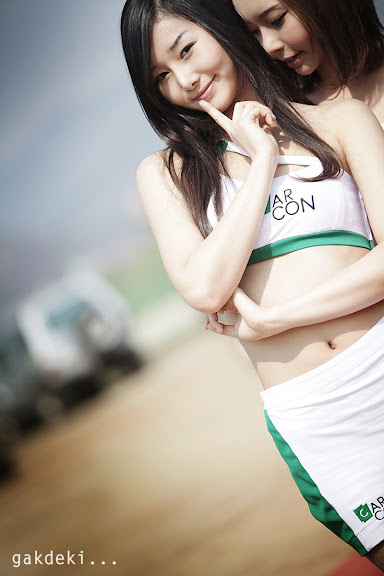





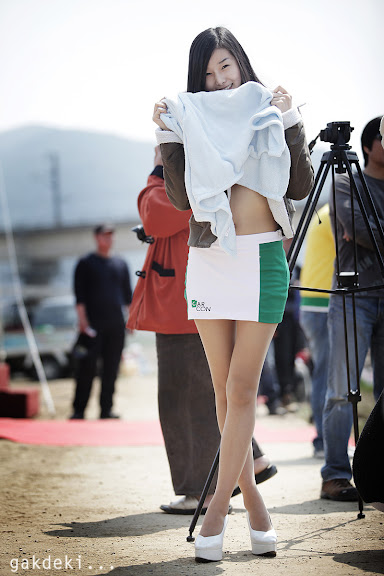



»» Read more
Han Song I (한송이) is going to grace the racing circuits for the first time!
Welcome to the world of Korean Racing Han Song I (한송이)!
More to come, stay tuned! :)











Song Ji Na (송지나) looking simply amazing in the Korea Top Crawler Championship 2010!
More to come! Stay tuned!
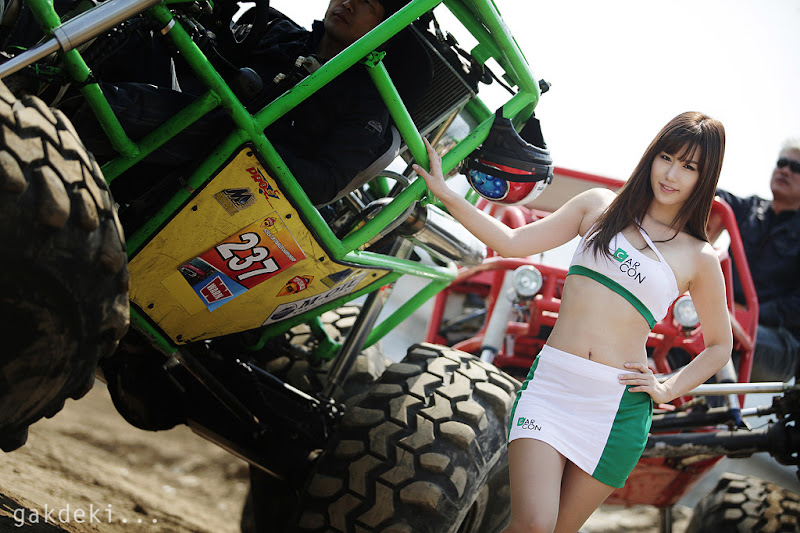






»» Read more
More to come! Stay tuned!







More Seongnam Scooter Race Championship 2010 Part 2 action!
One album upload (61 photo pack!!)
Part 1 action can be found here!
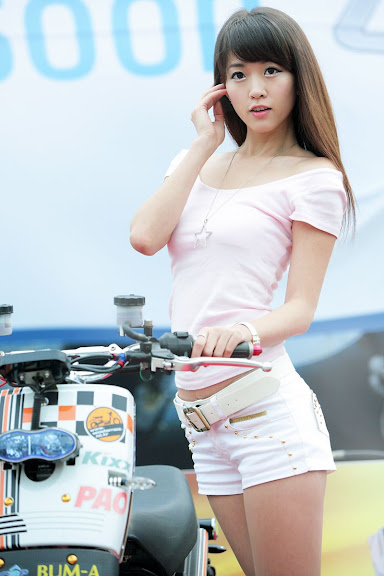


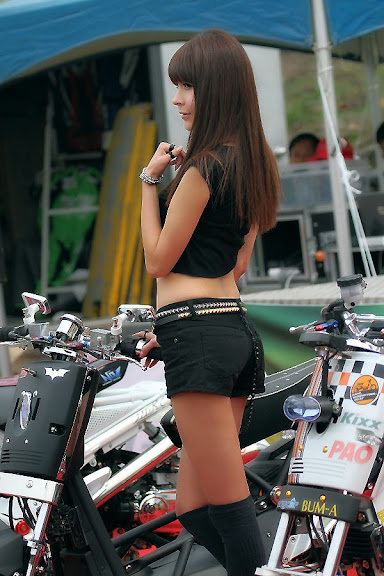






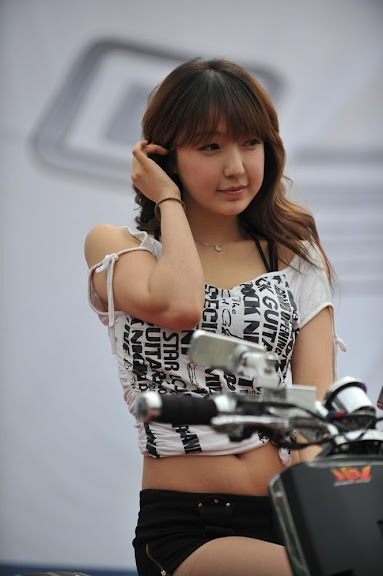





»» Read more
One album upload (61 photo pack!!)
Part 1 action can be found here!
















More Korean beauties for us to ogle; this time the event is the Seongnam Scooter Race Championship 2010!
One Korean Model that really stood out for me (despite the very tough elite competition) is none other than the graceful, elegant beauty Ahn Ri Na (안리나)!
With very minimal make-up, she can floor anyone with those natural-like graceful lines of hers... And don't forget her trademark dimples! Add a pair of hot legs; and you got that "perfect girl" you want to bring home to meet the parents!
With the likes of Choi Byeol Yee, Song Joo Kyung, Lee Sung Hwa, Kim Mi Hye, Kim Hyun Jin, Han Ji Eun etc. in this event; we are in for lots of eye candy treat!
Enjoy this album upload (71 photo pack!!!)

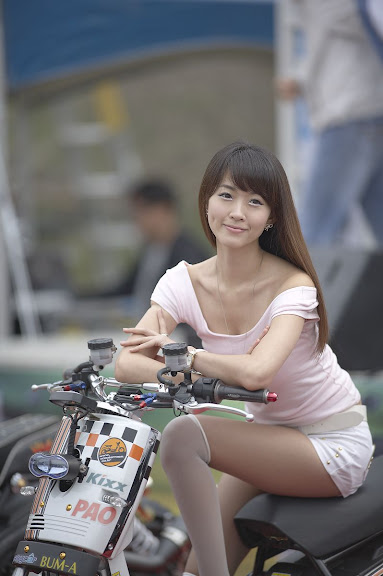


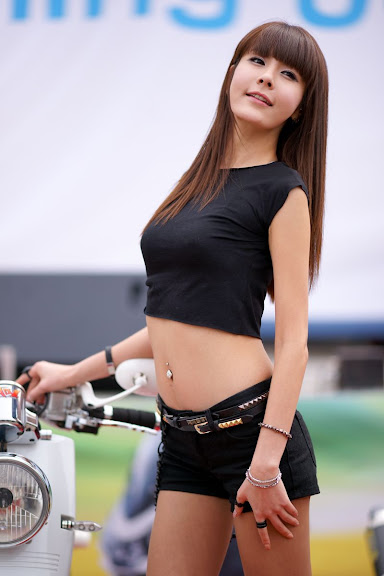


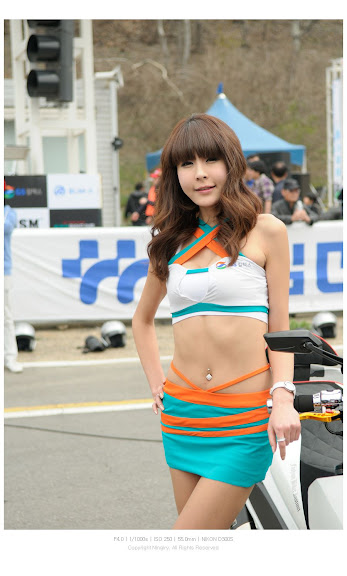
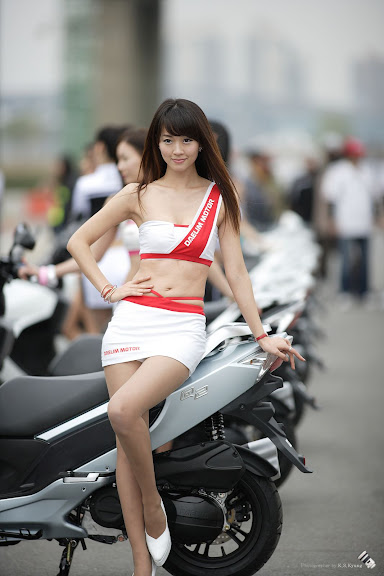




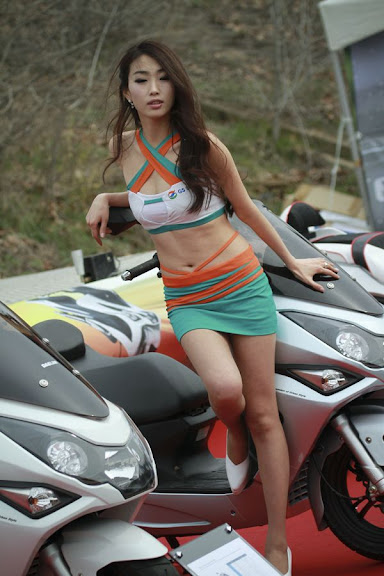



»» Read more
One Korean Model that really stood out for me (despite the very tough elite competition) is none other than the graceful, elegant beauty Ahn Ri Na (안리나)!
With very minimal make-up, she can floor anyone with those natural-like graceful lines of hers... And don't forget her trademark dimples! Add a pair of hot legs; and you got that "perfect girl" you want to bring home to meet the parents!
With the likes of Choi Byeol Yee, Song Joo Kyung, Lee Sung Hwa, Kim Mi Hye, Kim Hyun Jin, Han Ji Eun etc. in this event; we are in for lots of eye candy treat!
Enjoy this album upload (71 photo pack!!!)















